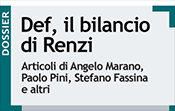Ultimi link in questa sezione
Usa S&P sotto inchiesta
The U.S. Justice Department’s action against Standard & Poor’s is a welcome, if long overdue, step in the prosecution of the rating agencies, which were some of the key culprits in the financial meltdown of 2008 and the ensuing economic slump.
There are both encouraging and disheartening aspects of the case. DOJ is making use of a law enacted in the wake of the savings & loan scandals of the 1980s—the Financial Institutions Reform, Recovery and Enforcement Act (FIRREA)—which permits it to seek penalties up to the amount of the losses suffered as a result of the alleged violations. During the period covered by the complaint, federally insured financial institutions suffered an estimated $5 billion in losses from the collateralized debt obligations that S&P is charged with giving inflated ratings. In other words, S&P may very well face a multi-billion-dollar hit.
On the other hand, despite the statement by Attorney General Eric Holder (photo) that the firm’s conduct was “egregious,” this is a civil rather than a criminal case, which means that no S&P executives will go to prison and S&P will be able to return to business as usual after it absorbs the financial blow. This is a repeat of the approach taken in the cases filed against the big banks.
At the press conference announcing the case, the head of DOJ’s civil division, Stuart Delery, noted that FIRREA allows prosecutors to seek civil penalties even though many of the underlying offenses are criminal in nature, including mail fraud, wire fraud and bank fraud. This, Delery emphasized, means that DOJ will have a lower burden of proof in making its case.
That’s convenient for prosecutors, but it lets S&P off a very large hook. Why couldn’t DOJ have brought civil and criminal charges?
Another limitation of this case, along with previous ones filed by DOJ, is that the rating agencies and the banks and investment houses that exploited their inflated ratings to peddle toxic assets are not being prosecuted at the same time. The use of separate cases means that the collusion between the groups—which can be called banksters and ratesters—is less likely to come to light.










